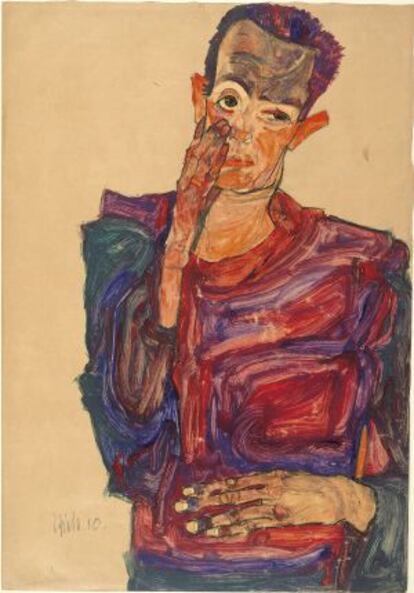Distortion effect
The disturbing drawings of expressionist Egon Schiele

The disquieting watercolor, gouache, ink, charcoal and chalk-scrawled figures of the great Viennese expressionist Egon Schiele (1890-1918) have just gone on show at the Guggenheim Bilbao as part of the events celebrating the museum's first 15 years.
More than 100 works from the archive of the Albertina museum in Vienna, holder of the biggest collection of works by the artist in the world, feature in the exhibition, which offers an in-depth examination of the conceptual, formal and thematic evolution of his work.
Schiele is an artist who goes on raising questions among historians and critics -- notably what might have happened if he had not died from Spanish flu aged 28, just as he was starting to enjoy genuine star status in Viennese artistic circles. This collection of works executed on low-quality paper, backed by rough wood, sums up the legacy of an artist who exuded uneasiness and non-conformism and learned to break the rules of color and line after studying the work of Vincent van Gogh and Edvard Munch.
It's an exhausting journey, covering the academic training that he quickly abandoned; his initial love affair with Viennese modernism and the Secession movement led by Gustav Klimt, his teacher and mentor; and the subsequent break that led him into the wild territory of expressionism. A narcissist who insisted he was his own best model, he represented himself with a thousand different faces in countless self-portraits.
He also had a passion for spiritualism, photographs of ghosts and pictures of schizophrenics and -- no doubt following the teachings of his compatriot Sigmund Freud -- he saw it as his non-negotiable mission to dive into the bottomless pits of sexual drives. This included making explicit drawings and paintings of sex, even involving children. "It is incredible; you have forgotten how sex fascinated us when we were kids," he told those who attacked him for painting naked children in his studio in the small town of Krumau, to where he fled to escape the asphyxiating and conservative Viennese society of the era.
The show also features drawings and watercolors from his prison series, made after he was locked up for three weeks after being convicted of exhibiting erotic drawings where children could access them. It was a traumatic experience for the fun-loving Schiele (despite what his self-portraits depict), but it could have been a lot worse. The initial charge (which was ultimately thrown out) had been "kidnapping and abusing minors" after a naval official reported him and his wife for taking his 13-year-old daughter, one of the girls who modeled for him, to Vienna.
Egon Schiele. Until January 6 at Guggenheim Bilbao, Avenida Abandoibarra 2, Bilbao. http://schiele.guggenheim-bilbao.es
Tu suscripción se está usando en otro dispositivo
¿Quieres añadir otro usuario a tu suscripción?
Si continúas leyendo en este dispositivo, no se podrá leer en el otro.
FlechaTu suscripción se está usando en otro dispositivo y solo puedes acceder a EL PAÍS desde un dispositivo a la vez.
Si quieres compartir tu cuenta, cambia tu suscripción a la modalidad Premium, así podrás añadir otro usuario. Cada uno accederá con su propia cuenta de email, lo que os permitirá personalizar vuestra experiencia en EL PAÍS.
¿Tienes una suscripción de empresa? Accede aquí para contratar más cuentas.
En el caso de no saber quién está usando tu cuenta, te recomendamos cambiar tu contraseña aquí.
Si decides continuar compartiendo tu cuenta, este mensaje se mostrará en tu dispositivo y en el de la otra persona que está usando tu cuenta de forma indefinida, afectando a tu experiencia de lectura. Puedes consultar aquí los términos y condiciones de la suscripción digital.
Últimas noticias
From Andorra to Gibraltar, a black market for Ozempic exploits its success: ‘They’re the most sought-after products in the world’
Magnets in their heads: How some animals guide themselves using the Earth’s magnetic field
From Hungary’s Orbán to Chile’s Kast: How Trump helps turbo charge the far right
The brief rise and retreat of Generation Z in Mexico
Most viewed
- Why we lost the habit of sleeping in two segments and how that changed our sense of time
- Trump’s obsession with putting his name on everything is unprecedented in the United States
- Charles Dubouloz, mountaineering star, retires at 36 with a farewell tour inspired by Walter Bonatti
- The Florida Keys tourist paradise is besieged by immigration agents: ‘We’ve never seen anything like this’
- Living in a motorhome due to soaring housing prices in Madrid: ‘I got used to it quickly, but I don’t idealize it’








































